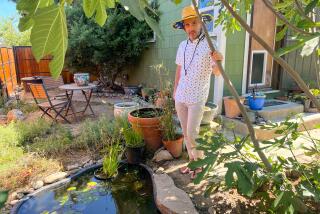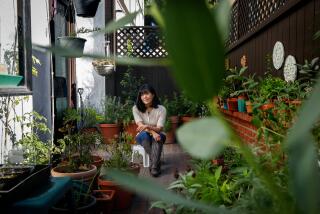Misting Aids Plants’ Need for Moisture
- Share via
Question: In this dry weather, I’m concerned about my houseplants. Should I be providing extra humidity?
A.C., Yorba Linda
Answer: Many houseplants originally come from tropical jungles where the air is heavy with humidity. This is not exactly a replica of most homes. Fortunately, many of these tropical descendants can live in the low moisture levels found in our homes.
To grow really well, however, most houseplants like a little extra humidity.
In general, houseplants do best between 30% to 40% humidity and most homes don’t provide high enough levels. The humidity of your home depends on a variety of factors, such as where you live (inland is drier). Heating and air-conditioning also lowers humidity.
You can test the humidity level of your home with a hygrometer, an instrument that measures moisture in the air. They can be found at some nurseries, hardware stores and through mail-order.
While some plants will hang in there despite low humidity, high moisture lovers like zebra plant (Aphelandra squarrosa), anthurium, orchids, fittonia, many palms, African violet, ferns, philodendrons and spathiphyllum are likely to falter without some additional moisture.
Signs that a plant isn’t getting enough humidity include leaves with brown edges and tips and yellowing. Leaf curling is another sign.
There are several things you can do to provide your houseplants with more humidity.
* Misting. Most houseplants--except for fuzzy-leaved ones like African violets--like regular misting.
Misters found at the nursery are generally best to use, because they can be adjusted according to the mist requirements of each plant.
Some plants want a very fine mist while others like to be more wet.
Using tepid or room temperature water, mist in the morning so the plants have time to dry out before night. Misting should create a fine fog of moisture that surrounds and covers each plant. Leaves should look as if light dew has settled on them.
Some plants want daily misting; others are OK with two to three times a week.
Besides misting, it’s also a good idea to rinse plants outside with a hose or in the bathtub at least twice a year. Not only does this provide them with moisture, it cleans the plant leaves and will prevent spider mite infestations.
* Humidity tray. Placing plants above water also provides them with moisture. It is the best way to humidify plants that can’t be misted because of fuzzy leaves that are susceptible to leaf spotting and rotting, such as African violets and the piggyback plant (Tolmiea).
Create a humidity tray by filling a waterproof plate or bowl with polished stones, pebbles or marbles. Add water, stopping when the water level is just below the top of the rocks. Place the plant on top of this, making sure that no water touches the bottom of the pot, as this can lead to root rot.
Humidity created in the water below will slowly rise to the plant. Check the effectiveness of your humidity tray by taking a reading near the foliage with a hygrometer.
* Grouping. The more plants you put together, the more humidity they create for one another. Group small plants, making sure to leave a little room in between each one for air circulation. Or try surrounding the base of larger plants with small ones.
Corn plant (Draceana fragrans ‘Massangeana’), palms, ctenanthe, banana and schefflera are large humidity lovers that look good surrounded by small moisture seekers such as arrowhead plant (Syngonium), pilea, caladium, croton (Codiaeum) and begonia.
* Consider location. Keep plants that like humidity out of all drafts, because continuous air movement will dry them out. Position them away from windows, doors and heating and air-conditioning ducts.
If the lighting is right, many plants can thrive in bathrooms and kitchens, which are naturally humid.
* Low-humidity lovers. Plants that get by without extra moisture include succulents, such as kalanchoe and sansevieria, Draceana marginata, fiddleaf fig (Ficus lyrata), yucca, pothos, ponytail plant (Beaucarnea recurvata), cissus and spider plant.
*
Have a problem in your yard? University of California Cooperative Extension (UCCE) Master Gardeners are here to help. These trained and certified horticultural volunteers are dedicated to extending research-based, scientifically accurate information to the public about home horticulture and pest management. They are involved with a variety of outreach programs, including the UCCE Master Garden hotline, which provides answers to specific questions. You can reach the hotline at (714) 708-1646 or send e-mail to [email protected]. Calls and e-mail are picked up daily and are generally returned within two to three days.






